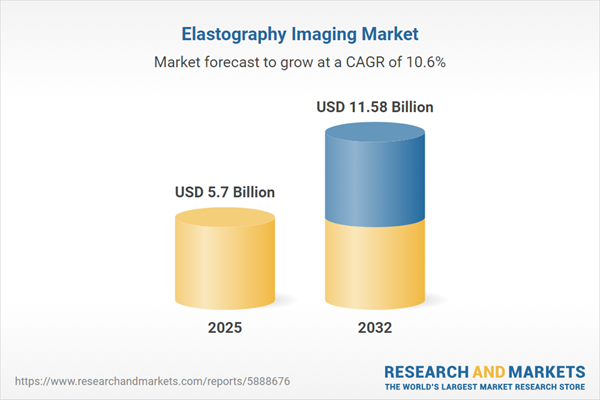Speak directly to the analyst to clarify any post sales queries you may have.
The Elastography Imaging Market is rapidly redefining standards for noninvasive diagnostic precision, supporting healthcare providers with advanced tissue characterization across a multitude of clinical settings. This report delivers focused intelligence for senior decision-makers seeking to understand growth drivers, technological progress, and actionable strategies in this evolving diagnostic segment.
Market Snapshot: Elastography Imaging Market Growth and Direction
The elastography imaging market grew from USD 5.15 billion in 2024 to USD 5.70 billion in 2025 and is projected to reach USD 11.58 billion by 2032, reflecting a robust CAGR of 10.64%. This expansion is fuelled by widespread adoption in oncology, hepatology, musculoskeletal, and endocrine evaluation, as healthcare facilities worldwide prioritize functional diagnostic imaging and operational efficiency. Market momentum is sustained by investments in next-generation hardware, analytics-enabled platforms, and integrated clinical applications.
Scope & Segmentation of the Elastography Imaging Market
The report provides comprehensive coverage of the elastography imaging market, with detailed segmentation based on product, component type, end user, technology, region, and leading organizations. Growth potential is highlighted in each segment as follows:
- Product: Magnetic Resonance Elastography; Ultrasound Elastography
- Component: Hardware; Services; Software
- End User: Academic Research Institutes; Diagnostic Imaging Centers; Hospitals
- Technology: Shear Wave Elastography; Strain Elastography
- Application: Breast Imaging; Liver Imaging; Musculoskeletal Imaging; Thyroid Imaging
- Region: Americas (United States, Canada, Mexico, Brazil, Argentina, Chile, Colombia, Peru); Europe (United Kingdom, Germany, France, Russia, Italy, Spain, Netherlands, Sweden, Poland, Switzerland); Middle East (United Arab Emirates, Saudi Arabia, Qatar, Turkey, Israel); Africa (South Africa, Nigeria, Egypt, Kenya); Asia-Pacific (China, India, Japan, Australia, South Korea, Indonesia, Thailand, Malaysia, Singapore, Taiwan)
- Key Companies: GE Healthcare Ltd., Siemens Healthineers AG, Canon Medical Systems Corporation, Koninklijke Philips N.V., Fujifilm Holdings Corporation, Samsung Medison Co., Ltd., Shenzhen Mindray Bio-Medical Electronics Co., Ltd., Hitachi, Ltd., Esaote S.p.A., Hologic, Inc.
Key Takeaways for Senior Decision-Makers
- Adoption is accelerating due to elastography’s noninvasive ability to assess tissue stiffness and elasticity, aiding earlier disease identification and monitoring.
- Hardware miniaturization and machine learning integration improve point-of-care accessibility, enabling deployment outside traditional hospital environments.
- Demand is rising for modular systems that support a range of applications, with hospitals seeking comprehensive, multidisciplinary diagnostic platforms and imaging centers focusing on operational efficiency.
- Shear wave elastography is seeing increased preference where quantitative analysis is required, while rapid qualitative techniques also retain strong relevance across clinical workflows.
- Segment needs vary regionally, with reimbursement structures, healthcare infrastructure, and awareness levels driving uptake in each territory.
- Collaborations among equipment manufacturers, digital health firms, and research institutions facilitate innovation, clinical validation, and tailored software development.
Tariff Impact: U.S. Policy Shaping Market Dynamics in 2025
New United States tariff measures introduced in 2025 have influenced supply chains for imaging equipment, with higher import duties on essential components increasing costs and extending approval lead times. In response, manufacturers are investing in regional partnerships and diversifying procurement sources, while healthcare providers leverage bundled service contracts to stabilize operational spending. These adaptations foster greater supply chain resilience and could spur locally focused technological development in elastography imaging.
Elastography Imaging Market: Methodology & Data Sources
The research methodology combines deep-dive primary interviews with radiologists, technicians, biomedical engineers, and C-level healthcare executives, alongside secondary analysis of peer-reviewed journals, regulatory documentation, and financial reports. Quantitative validation utilizes shipment data, utilization rates, and procurement records, while qualitative triangulation ensures a robust and accurate market perspective.
Why This Report Matters to Strategic Leaders
- Supports effective investment planning and product portfolio strategy by enabling identification of growth opportunities by region, application, and technology.
- Facilitates operational risk management with analysis of policy shifts, supply chain disruptions, and evolving regulatory frameworks specifically impacting the elastography imaging market.
- Empowers evidence-based collaboration and innovation by mapping competitive moves and partnership activity across major vendors and clinical stakeholders.
Conclusion
The elastography imaging market is positioned for sustained growth, driven by technology innovation, clinical demand, and adaptive business strategies. Senior leaders equipped with this report will be prepared to navigate complex market dynamics and capture emerging opportunities in diagnostic imaging.
Additional Product Information:
- Purchase of this report includes 1 year online access with quarterly updates.
- This report can be updated on request. Please contact our Customer Experience team using the Ask a Question widget on our website.
Table of Contents
3. Executive Summary
4. Market Overview
7. Cumulative Impact of Artificial Intelligence 2025
Companies Mentioned
The companies profiled in this Elastography Imaging market report include:- GE Healthcare Ltd.
- Siemens Healthineers AG
- Canon Medical Systems Corporation
- Koninklijke Philips N.V.
- Fujifilm Holdings Corporation
- Samsung Medison Co., Ltd.
- Shenzhen Mindray Bio-Medical Electronics Co., Ltd.
- Hitachi, Ltd.
- Esaote S.p.A.
- Hologic, Inc.
Table Information
| Report Attribute | Details |
|---|---|
| No. of Pages | 197 |
| Published | October 2025 |
| Forecast Period | 2025 - 2032 |
| Estimated Market Value ( USD | $ 5.7 Billion |
| Forecasted Market Value ( USD | $ 11.58 Billion |
| Compound Annual Growth Rate | 10.6% |
| Regions Covered | Global |
| No. of Companies Mentioned | 11 |









